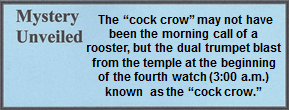14.02.20 Lk. 22:35-38
FULFILLMENT OF ISAIAH’S PROPHECY
35 He also said to them, “When I sent you out without moneybag, traveling bag, or sandals, did you lack anything?”
“Not a thing,” they said.
36 Then He said to them, “But now, whoever has a moneybag should take it, and also a traveling bag. And whoever doesn’t have a sword should sell his robe and buy one.
37 For I tell you, what is written must be fulfilled in Me: And He was counted among the outlaws (Isa. 53:12). Yes, what is written about Me is coming to its fulfillment.”
38 “Lord,” they said, “look, here are two swords.”
“Enough of that!” He told them.
“And whoever doesn’t have a sword should sell his robe and buy one.” This passage is a difficult to understand for two reasons.
- There is the historic opinion that Jesus was a conscientious objector and, therefore, was opposed to any form of violence.
- Jesus had previously sent His disciples out on a missionary journey without any supplies and now He was sending them out fully equipped and armed. Why was there a difference? In verse 35 Jesus reminded His disciples that God had provided for all their needs on a previous missionary journey (ies), but now things had changed (v. 36). Jesus realized that the political winds were about to change and the provisions needed for future ministry would be supplied by God in a different manner. The people whom they would meet along the way, would not be as giving.[1]
Why did Jesus tell them to get a sword? What purpose did He have in mind? The answer is that, when traveling, it was common practice for every man to carry a short sword, known as a gladius.[2] It was easily worn under the outer garment or on the side. Josephus reported that the Essenes carried swords to protect themselves from bandits, when they traveled to the homes of other Essenes. Note the words of the historian, Josephus,
They have no certain city but many of them dwell in every city; and if any of their sects come from other places, what they have lies open for them, just as if it were their own; and they go into such as they never knew before as if they had been ever so long acquainted with them. For which reason they carry nothing with them when they travel to remote parts, through still they take their weapons with them, for fear of thieves.
Josephus, Wars 2.8.4 (124-125a)
14.02.20.Q1 Did Jesus approve of His disciples carrying weapons?
This question is difficult to answer, especially in light of the fact that it is impossible to think of Him as needing a weapon. Does this mean, however, that He forbade His disciples to carry them? No one would ever have thought of traveling anywhere completely defenseless; traveling was always dangerous.[3] If thieves did not threaten travelers, then the Sicarii (as the Romans called them) or the Zealots (as the Jews called them), or a host of wild animals such as the Syrian brown bear (05.02.03.D) and the caracal lynx (05.02.03.E) would threaten and possibly kill them.
As previously stated, the disciples had traveled with Jesus for more than three years. It was the custom that a master would closely mentor his disciples similar to a parent-child relationship. This is an important point, because most certainly, the disciples understood how Jesus felt about such things as weapons. If these were not to be a part of their lives, He would certainly have told them long before now.
The gladius was as common in ancient times as the Boy Scout pocket knife once was in America. For a man to carry a short sword was nearly as common as walking with sandals. A gladius was a convenient tool that could clean a fish, sever firewood, create a spark with a flint for a cooking fire, or be used in self-defense against bandits or animals. Note that Jesus did not forbid the use of swords, nor forbid His disciples to carry them. This does certainly not mean He taught any type of military or armed conflict. Later He would tell them that those who live by the sword shall die by the sword (Mt. 26:52), which is hardly a command that would be spoken by a political revolutionary.
Finally, in verse 38 Jesus said, “Enough of that!” The difficulty with this passage is that the ancient writings had no quotation marks, exclamation marks, or other indicators to identify emotions, quotations, or questions. Therefore, readers were left with the task of creating an educated guess as to how the phrase was originally stated. It is the opinion of this writer that this was not a calm sentence, as if to imply that no additional swords were needed. Jesus knew all too well what the next few days were going to be like and another missionary journey was not on the agenda. At the thought of having more swords, Jesus emphatically said, “THAT IS ENOUGH!”[4] Ironically, Jesus embodies the paradox of uniting Jews with Christians and separating Jews from Christians.
[1]. Bock, Jesus According to Scripture. 365-66.
[2]. Dixon and Southern, The Roman Calvary. 48.
[3]. Josephus, Antiquities 20.6.1(118); Wars 2.15.6 (232).
[4]. Kaiser, Davids, Bruce, and Brauch, Hard Sayings of the Bible. 486-88.
